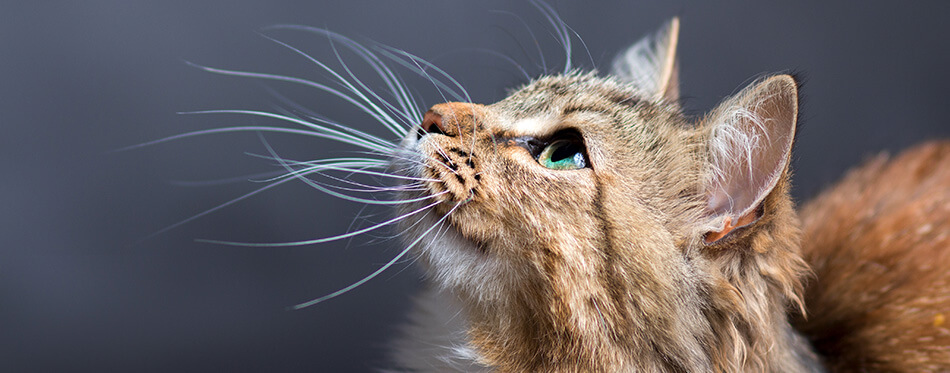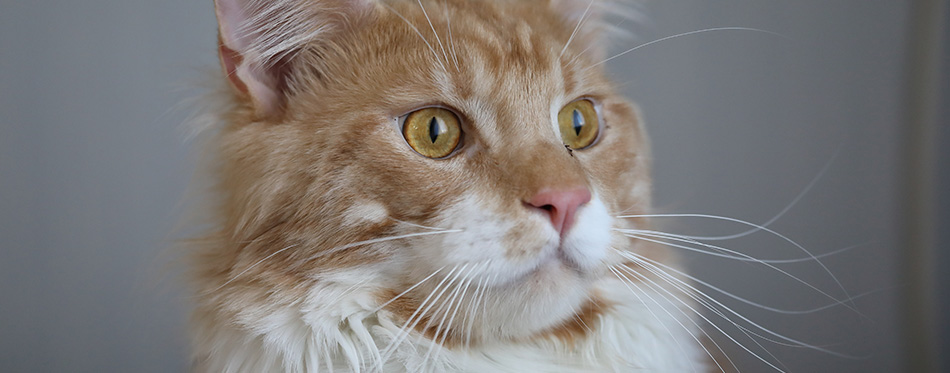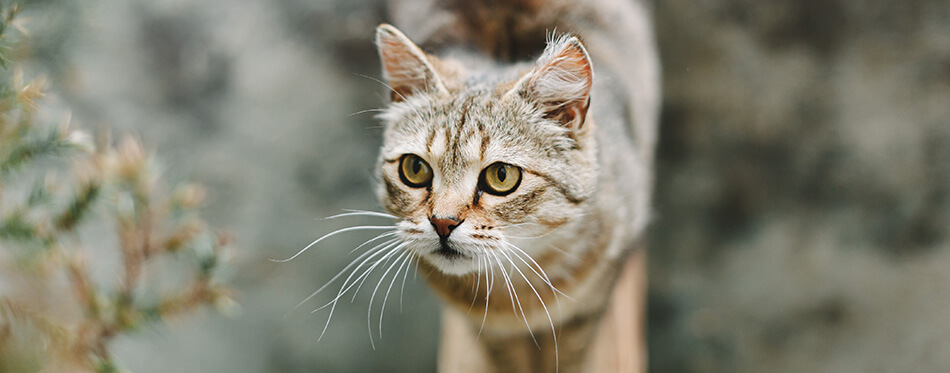It’s always a stressful experience when you notice something different about your feline friend. Every pet parent wants the best for their cat – and rightly so. After all, new cat owners can only know what’s normal and what’s not, based entirely on their instinct and articles like these. From skin ailments to fighting with other animals, there’s a wide range of reasons as to why you’ve noticed some missing whiskers.
Whether you’re finding that cat’s whiskers are dropping like flies, or you’ve spotted one or two whiskers around the house, finding the right answers for why this is happening is important. So, if you notice your cat losing whiskers and find yourself worrying, then feel safe in the knowledge that we’ve got all the answers for you, right here.

Why Do Cats Need Whiskers?
Just like the family dog, a cat has whiskers around their nose, chin, and eyes. Sitting deeper in the skin than their other hair, they send constant streams of “communication” to the nerves situated in these areas. Think of it as how your cat collects “personal data” since it feeds back to the brain on a constant basis.
While most people understand that your dog and/or cat has whiskers to navigate through smaller spaces. Which is a good reason why you should never trim the whiskers of a dog or cat! Of course, the truth is that they’re much more complicated than many realize.
Whisker loss is about much more than changing the aesthetics of your cat’s face.
Also called vibrissae (for both dog and cat whiskers), these are responsible for changes in the air, including pressure and movement. As such, these whiskers allow your cat to find prey, avoid attack and be able to sense when something changes around them.
In other words, a cat losing whiskers can mean that they’re unable to function as they usually would. Especially if the whiskers fall out all at once. Indeed, many people are surprised to learn that if their dog or cat loses whiskers, they can quickly lose balance, as well as confidence in traversing their surroundings.
Do Cats Shed Whiskers?
So, the answer to the all-important question of “do cat whiskers fall out?” is…absolutely! Cat’s whiskers will regularly shed and regrow on a rolling basis. As such, it’s unlikely that pet owners will be actively aware of this happening. For those who are new to owning cats, losing whiskers doesn’t necessarily mean there is anything wrong.
Indeed, your cat losing whiskers can indicate that they’re perfectly healthy since your cat’s whiskers are designed to shed and regrow, regularly. However, if you’ve noticed that your cat is losing all her whiskers, then this could be a sign that something else is going on.
Why Do Cats Lose Whiskers
Think of the whiskers on your cat as being similar to our eyelashes. For cats, their “eyelashes” are based around their chin, above their eyes, and around their mouth. For most cats, many of these (particularly around the chin and above the eyes) are hard to spot, as they’re generally very fine hairs.
A cat will shed fur in the same way we experience hair loss – you can see it almost everywhere. But, when it comes to whisker loss, you shouldn’t look over at your feline friend and be able to see fewer whiskers – just as we can’t tell when we’ve lost eyelashes. This is because the shedding often happens once we (and your cat) have already grown fresh whiskers, before the older, now-defunct whiskers will shed.
As such, normal shedding should be almost unnoticeable.
However, if a cat owner suddenly finds that their feline friends have small spaces between their whiskers, this is a sign that your cat lost more whiskers than is normal. As such, cat lovers should call their veterinarian, to ensure that the shedding of your cat’s whiskers isn’t a sign of something more sinister.
Losing whiskers is totally normal.
You are more likely to notice house-cats losing whiskers than feral cats or outdoor cats, purely because your cat will lose whiskers regularly. As such, this regular whisker loss will lead to more whiskers being left around the house. Most likely, they’ll fall out and be discovered in your cats’ favorite sleeping spots or toys.

When to Worry About Your Cat’s Whiskers Falling Out
While it’s important to remember that, like human hair, cat’s whiskers start shedding and regrowing on a regular basis, there are sometimes other reasons for whisker loss. Finding a few whiskers here and there is never a cause for alarm. Indeed, it’s purely about your cat ensuring their current whiskers stay healthy enough to do their job.
Of course, some whisker loss can mean you need to take your cat (or even dogs, if they’re losing whiskers) to the vet for a check-up. Here is a basic list of the most common causes for concern are, when it comes to why your pet is losing whiskers. As well as what you can do to help resolve these, while waiting for further advice from your veterinarian.
Multiple Cats (and Other Animals) Losing Whiskers
Humans, cats, and dogs can all lose hair and whiskers at different rates, according to their own body’s needs. However, if you spot other cats in the household (or even in the local area) all suffering from the same thing, this is a surefire sign that something contagious is going around. At times, this can be caused by something like mange, which in turn is caused by parasites.
Sometimes, however, the stress of being around other pets can also cause feline alopecia in general. So, if you’ve just brought a new kitten, dog, or other pet into the household, this can sometimes cause stress. The stress can manifest as over-grooming and your cat will lose fur all over their body.
As such, cat owners can work to help maintain harmony between their cats and dogs, by using a couple of tricks we highlight in one of our new posts. Just be aware that this is a slow process and not all dogs or cats are the same. As such, it can take a while for both your dog and cat to become used to each other and understand that neither is a threat to the other.
Bacterial and Fungal Infections
Bacterial and fungal infections are some of the most common reasons as to why cats lose their whiskers. Since a fungal infection can cause inflammation, as well as skin irritation, it doesn’t take long for scratching, grooming, and inflammation to cause the whiskers to fall out.
The most common culprit is Ringworm. Which, despite its name, is not a worm – but is actually a fungal infection. This is highly contagious, so if you spot your dog or any local cats and dogs losing their fur, it’s highly likely that your cat has ringworm. It can also pass on to humans, so be mindful of symptoms in yourself, too. Check out our guide on dewormers for cats for more info.
If you suspect bacterial/fungal infections, give your local vet a call, as you’ll likely need a combination of topical and oral medications. In the meantime, give their bed a blitz and buy new posts and toys, to help sterilize your cats’ environment.
Symptoms
The most common symptoms of fungal or bacterial infections include:
- Inflamed skin
- Thick patches of skin
- Scales or scabs across your cat’s fur
- Patchy hair/fur loss
- Whisker loss
- Rough/scaly claws
Feline Acne
Feline acne, also called cat acne, or even follicular keratinization if you’re feeling formal, is surprisingly common in cats (it can also be found in dogs). It’s caused by the excessive production of keratin (a protein that makes up the hair) and is most common in the hair around the chin area. It can be caused by a range of different things, including hormone imbalances and a poor immune system.
Just like humans, it shows up on your pet as blackheads and whiteheads. Although, due to the amount of fur, combined with the color of the pimples, it’s harder for many owners to notice the changes, compared to normal skin. Often, many people – including the vet – can only notice the change when the area around the whisker of your pet begins to fall out.
Sometimes, feline acne can disappear, just as suddenly as it appears. However, many cats have recurrences – especially if the first outbreak starts as a kitten. It is differentiated from allergies by the spots produced, which can also be revealed as blackheads. Interestingly, though, feline acne can occur as a result of allergies, too.
Symptoms
- Lumps and bumps around the area
- Spots and pustules
- Redness
- Scabs
- Whisker loss
Fleas
It’s not uncommon for a kitten to get fleas – particularly as most flea treatments aren’t suitable for young kittens (you’ll need to call your vet if you’re looking for a treatment for very young cats). They’re easily and quickly picked up by cats and dogs – and are highly contagious. Find out more about flea treatments for cats here.
They’re not just found in feral cats, as the parasites can live almost anywhere and jump onto your cat when they go outside. They can even jump onto your clothes and hop off again once inside your home – meaning that your indoor cats are susceptible, too.
Sometimes, flea bites can also cause an allergic reaction. In these cases, it’s worth calling your vet, since your cat will continue to scratch, long after the fleas themselves have been dealt with. If you spot your cat scratching, despite knowing that your home is flea-free, then this falls outside of the realm of normal. As such, it’s likely that they’ll be suffering from an allergic reaction to the bites.
Symptoms
- Constant scratching
- Unnatural shedding of fur
- Excessive grooming
- Black specks in their bed or on their skin
- Whisker loss
Allergic Reaction
Often, an allergic reaction can come from the food that your cat is eating. In these cases, it’s worth trying different types, including hypoallergenic cat foods, to see if it improves your cat’s wellbeing. Of course, if this doesn’t work, a trip to the vets might be in order.
If your cat is suffering with breathing difficulties or problems with their eyes, nasal passage, ears and mouth, call a vet straight away. However, most reactions are – thankfully – mild. Still, if you think this is the cause of your cat’s whiskers falling out, then it’s worth giving them a call anyway. Your vet can offer steroid injections, as well as topical treatments and general advice on how to minimize the problems associated with the reactions.
Allergies can come in many forms, including as a food allergy or even an allergy to flea bites, as mentioned above. This allergic reaction causes the skin to become inflamed, sore, and dry. It also means that your cat is likely to shed more and whiskers are more likely to fall out, from the constant scratching.
Symptoms
- Itchy skin
- Whisker loss
- Sneezing
- Runny nose
- Watery eyes
- Rash or hives
Physical Trauma
Cats are territorial animals. And, if you’re not lucky, it can be easier for your cat to get into a scrap with another cat who encroaches on their space – or vice versa. Most scraps between cats don’t leave any lasting damage, but it can lead to your cat losing some whiskers or having some minor scratches and scrapes.
If you do spot your cat throwing fists with another cat, never put yourself between the two. Instead, make a loud noise or run toward the pair. Often, this is more than enough to cause the two to split ways and make a run for it. Good luck!
When To Call A Veterinarian About Your Cat’s Whiskers
If you’ve noticed a number of whiskers falling out, then it’s always wise to give your vet a call. There doesn’t need to be many whiskers that your cat has shed, before you decide to take your pet to the local vet. After all, many of the reasons above come with their own signs and symptoms, which can help to indicate why your cat’s whiskers fall out.
In other words, if you’ve noticed a couple of whiskers around the home, but your cat seems perfectly happy and healthy in themselves, then this is normal shedding. However, if you’re worried about your cat for any reason, and one of the symptoms of that their whiskers are falling out, then be sure to tell your veterinarian when you call. Particularly as this can help your vet to narrow down the causes.

How Many Whiskers Can A Cat Lose Before It’s Unhealthy?
If you’ve noticed small spaces or patches between whiskers, it’s likely that your cat is suffering from one of the above. Most of the time, the central issue can be easily resolved with some simply topical or oral medications. However, if you notice a change in behavior, weight loss or lethargy, always call the veterinarian – even if your cat still has most of its whiskers.

